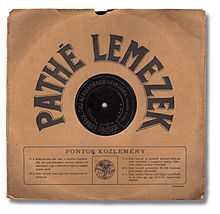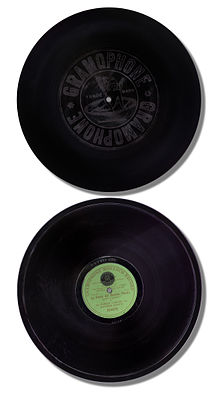Shellac record
The shellac record is the forerunner of the vinyl records that are still produced and often found today . Both are named for the material they are usually made of.

Shellac records usually had a diameter of 10 inches (about 25 centimeters) or 12 inches (about 30 centimeters) and mostly grooves were written in side letters, which can be scanned with an ordinary gramophone with a thick steel needle or with an electric record player with a special needle. 10-inch shellac records offered a maximum of a little more than 3 minutes, 12-inch shellac records a little more than 4 minutes of playing time per side. The latter was primarily interesting for classical pieces of music.
Another characteristic feature of the shellac record is the playback speed: There have been tests with 60 to over 100 revolutions per minute, with 78 min −1 prevailing. As early as 1930, however, there were isolated "long-play" shellacs that ran at 33 1/3 min −1 and offered a good 10 minutes of music per side, for example with excerpts from stage shows; Their sound quality was (still) significantly lower than that of the "78s" .
history

In October 1896, the inventor and entrepreneur was Emil Berliner , the use of hard rubber in sheets and replaced the substance by one of the Duranoid Co., Newark, New Jersey, produced molding compound, consisting essentially of shellac was as a binder and originally insulators developed had been. The shellac bound the other components, the fillers barium sulfate , slate flour, soot and cotton flock, to form a wear-resistant mass. The innovation improved the sound quality and durability of the records enormously, but a disadvantage was the high degree of brittleness and the risk of breakage.
As long as one wanted records that could also be played back aloud mechanically via a sound box, i.e. without electrical amplification, there was no viable alternative. In the USA, several factors came together in the 1940s that suggested a change from shellac material to PVC (vinyl) : On the one hand, record players with electric cartridges had established themselves, on the other hand, shellac had to be imported.
Since it is a decisive sales argument for records that are intended for children that they are practically unbreakable, about 1944 they started to be pressed in PVC, but still with a wide groove and 78 turns.
Vinyl records, in which the other advantages of the material, that it allows lower playback speeds and thus a longer playing time, were exploited, were only available for radio use and as test and demo pressings until 1948. It was only then that vinyl records with microgrooves and suitable playback devices for use at home were released.
Shellac records were produced in the Federal Republic of Germany until 1958, in other European countries until the early and in the so-called Third World until the late 1960s. The last plates are said to have been pressed in South Africa in 1972. Up until the early 1980s, almost all turntables were equipped with a speed setting of 78 min −1 , could easily be fitted with needles for shellac records and were therefore suitable for this record format.
Manufacturing
All raw materials (a shellac record) are carefully examined for foreign bodies in order to then be crushed and ground into the finest powder in mixing and rolling systems. Among other things, the mass goes through tube mills that are about 10 m long and filled with many thousands of kilograms of small iron rolls. These roles result in a further mixing and intimate connection of the raw materials. The dust mixture achieved in this way is fed to another mixer from a bucket elevator via an automatic scale . From this mixer, the powder comes to the rolling mill in iron boxes. Each rolling mill consists of two adjacent rollers that are heated by steam. The heat turns the powder into a dough-like, plastic mass which, after thorough mixing, is removed and transferred to a cooled calender . The calender rolls the mass into thin, wide strips of tape, which are divided into square pieces by knives in the longitudinal and transverse directions.
After the strip of tape has solidified, it is broken up into individual sheets and packed in boxes and taken to the press shop. The fitter clamps one die each into the press , which consists of the press head and press plate, the two sides of the sheet to be formed. The press has the task of warming the pressed material delivered to it in sheets on a heating table, filling it up and placing it in the open press. The labels he added are pressed in at the same time. All other operations are carried out automatically.
The plates coming out of the press go to the revision, where each plate is examined for pressing and blemishes. Faulty panels are broken in again. The flawless panels come to the grinding shop. There they are freed from the still adhering mass by grinding between two rapidly rotating discs. Every 25th record in every press goes to music testing. If a manufacturing defect is found, the press in question is stopped immediately and all pressings carried out so far are checked. The finished panels are packed in panel bags and go to the sorting room, from where they are transferred to the various warehouses.
Scanning the plate
In the case of a gramophone for shellac records with side writing, as was common in Germany, a new needle usually has to be inserted after playing one side of the record.
For the scanning of shellac records, a number of mutually incompatible systems were initially on the market. Before the First World War , the French company Pathé was still well represented on the world market with its own inscription plate system. Since Pathé already had a large pool of phonograph cylinders at the time of the appearance of shellac records, the basis of which was also subscript and which this company copied mechanically onto its records, the company was able to enter the business with a range that was unexpectedly large for the time . The records recorded with subscript should not be played with a gramophone needle. For them there is a specially rounded sapphire that, depending on the plate size, makes the Pathé discs ring at 80 to 90, 90 to 100 or even 120 to 130 rpm . The Pathéphone was available for the records or a Pathé sound box as an adapter for gramophones , the special feature of which is the diaphragm that is perpendicular to the groove (in contrast to the horizontal membrane in the Edison sound boxes and the sound box in the gramophones, which is arranged parallel to the groove) . Initially, Pathé's plates always ran inside out and were provided with engraved inscriptions instead of labels. This only changed in the 1920s. At that time, Pathé also adopted the internationally common page writing process and released many recordings in parallel in both formats. Pathé records were pressed in various sizes, ranging from around 17 cm in diameter to 50 cm in diameter, and then sold as the Pathé Concert Record . These are the largest ever commercially produced records, which offered a significantly higher volume than the normal ones with the same playing time, and the associated playback devices with correspondingly long tone arms are very rare today. The latter were mainly intended as star-tone devices for use in restaurants and some were already equipped with a coin slot.
Another early variant was the North American "Edison Diamond Disc" (sometimes marketed as "Edison Recreation Disc"), which was not made of shellac and was six millimeters thick. These records, which are rather rare in Europe, cannot be played on the gramophone either. Edison had developed the "Disc Phonograph" for this, which was characterized by an extremely good sound quality, but also by sophisticated technology.
For the usual shellac record with side writing, not only a speed of (usually) 78 min −1 is necessary, but also a suitable pickup . Since the grooves on shellac records are wider than those on vinyl records, the needle for scanning must be correspondingly thicker; A rounding radius of 65 µm is common.
(Thin) needles intended for vinyl records would not produce good sound quality on shellac records and could be damaged. (Thick) needles intended for shellac records jump out of the narrow grooves on vinyl records or squeeze them wide and thereby destroy them.
In the case of a turntable that is intended for both types of records, the pickup usually contains two needles that can be switched over using a lever. If switching is not possible, the needle must also be changed when changing the plates.
After the advent of vinyl records, shellac records were marked with an N (for normal grooves) in a square, while vinyl records were given an M (for microgrooves) in a triangle. The levers for switching the needle on the turntables were marked accordingly (partly by letters, partly only by symbols, each in green for the normal needle and red for the microneedle).
See also
literature
- Martin Fischer: The fascination of shellac: gramophones, shellac records, needle boxes. Battenberg Verlag, Regenstauf 2006, ISBN 3-86646-008-2 .
- Fritz Bergtold: Modern record technology. Pocket textbook of vinyl records playback. Franzis-Verlag, Munich 1959.




